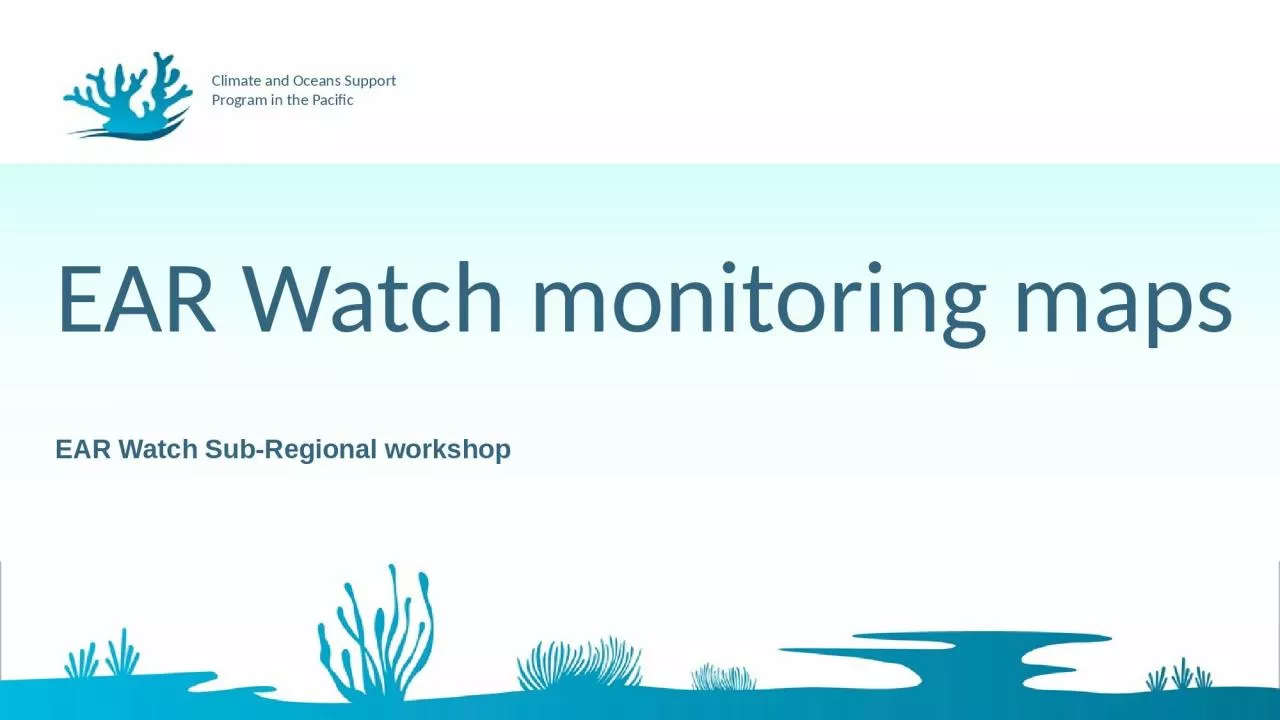

EAR Watch SubRegional workshop Climate and Oceans Support Program in the Pacific Only about 1 of the world can be accurately represented by rain gauges Kidd et al 2017 and it is often physically and economically difficult to expand the network including over many South Pacific Islands ID: 1025716
Download Presentation The PPT/PDF document "Zhi-Weng Chua EAR Watch monitoring maps" is the property of its rightful owner. Permission is granted to download and print the materials on this web site for personal, non-commercial use only, and to display it on your personal computer provided you do not modify the materials and that you retain all copyright notices contained in the materials. By downloading content from our website, you accept the terms of this agreement.
1. Zhi-Weng ChuaEAR Watch monitoring mapsEAR Watch Sub-Regional workshopClimate and Oceans Support Program in the Pacific
2. Only about 1% of the world can be accurately represented by rain gauges (Kidd et al., 2017) and it is often physically and economically difficult to expand the network, including over many South Pacific Islands.Example of gauges available around the world (Beck et al., 2019)Observations gap
3. South Pacific stations
4. Blend of gauge, satellite and model reanalysis data, weighted by their accuracy to gauges.Stations from GHCN-D database (Menne et al. 2012), the GSOD database (https://data.noaa.gov), the Latin American Climate Assessment and Dataset (LACA&D) database (http://lacad.ciifen.org/), the Chile Climate Data Library (www.climatedatalibrary.cl), and national databases for Mexico, Brazil, Peru, and Iran are used.Left to right: Relative accuracy of rainfall estimates as indicated by their weight into the Multi-Source Weighted Ensemble Precipitation (MSWEP) dataset (Beck et al., 2019)Multi Source Weighted Ensemble Precipitation (MSWEP)
5. One of the key points is that we are comparing values to their own climatology, reducing reliance on absolute accuracy of values.SPI is a commonly-used indicator of rainfall deficienciesSPI is the World Meteorological Organization StandardSPI standardises rainfall anomalies for a particular period to a normal distribution (NCAR, 2018)Standardized Precipitation Index (SPI)
6. MSWEP record goes back to 1980, we start the SPI record at 1981 to enable 12-month SPI to be created.Generate SPI at each grid point using a 40-year record to 2020.Standardized Precipitation Index (SPI)
7. The SCOPIC drought tool methodology was then applied to these gridded SPI, creating gridded drought status maps.Drought status
8. One month SPI can be noisy, resulting in discrepancies to station values.There appears to be artifacts over topography in the near-real-time data.Limitations behind the maps
9. Studies have shown it to be one of the best performing datasets available [Beck et al (2017); Beck et al (2019)]Performed our own analysis comparing data over Solomon Islands, PNG, Kiribati, Tuvalu, Marshall Islands, Cook Islands and Fiji.MSWEP performed the best, ERA5 was a close second. GSMaP can be accurate but the relatively short record affects its use for climatological analysis.Validation and why MSWEP?
10. ERA5 (1981-2020)MSWEP (1981-2020)Stations (1981-2020)GSMaP (2001-2020)Example of monthly climatology – Nadi, Fiji
11. Five most severe droughtsMSWEPERA5StationsGSMaP
12. MSWEP performs best, though ERA5 also does well.Hanan Airport, Niue, 1982 - 1983ERA5MSWEPStationGSMaP
13. MSWEP has the most matching timing even though it ends two months later. ERA5 is not bad but has breaks.ERA5MSWEPStationGSMaPPort Moresby, PNG1986 - 1988
14. MSWEP and ERA5 perform decently, though both do not capture a break towards the end.Honiara, Solomon Islands1991 - 1993ERA5MSWEPStationGSMaP
15. MSWEP and ERA5 perform well.Tarawa, Kiribati1998 - 2001ERA5MSWEPStationGSMaP
16. MSWEP performs best, followed by GSMaP.Majuro, Marshall Islands2012 - 2014ERA5MSWEPStationGSMaP
17. MSWEP has the most matching timing, ERA5 and GSMaP have breaks.Nadi, Fiji2014 - 2016ERA5MSWEPStationGSMaP
18. Funafuti, Tuvalu, 1998-2000MSWEP performs best.
19. Penhryn, Cook Islands, 1982-1983Aall datasets have breaks, GSMaP is the best.
20. Interpreting drought monitoring mapsSPISCOPIC entry/cancellation criteria appliedThe SCOPIC drought tool methodology was then applied to these gridded SPI, creating gridded drought status maps.
21. Country scale (Cook Islands)
22. Drought status for multiple timescales1-month12-month6-month3-month
23. Accessing mapshttp://www.bom.gov.au/climate/pacific/outlooks/
24. Keyantash, John & National Center for Atmospheric Research Staff (Eds). Last modified 07 Aug 2018. "The Climate Data Guide: Standardized Precipitation Index (SPI)." Retrieved from https://climatedataguide.ucar.edu/climate-data/standardized-precipitation-index-spi.Beck, H. E., Vergopolan, N., Pan, M., Levizzani, V., Van Dijk, A. I. J. M., Weedon, G. P., Brocca, L., Pappenberger, F., Huffman, G. J., and Wood, E. F.: Global-scale evaluation of 22 precipitation datasets using gauge observations and hydrological modeling, Hydrol. Earth Syst. Sci., 21, 6201–6217, https://doi.org/10.5194/hess-21-6201-2017, 2017.Beck, H. E., Pan, M., Roy, T., Weedon, G. P., Pappenberger, F., Van Dijk, A. I. J. M., Huffman, G. J., Adler, R. F., and Wood, E. F.: Daily evaluation of 26 precipitation datasets using Stage-IV gauge-radar data for the CONUS, https://doi.org/10.5194/hess-23-207-2019, 2019.References